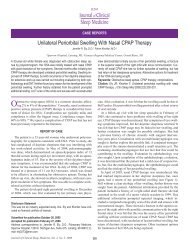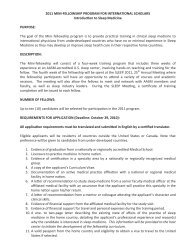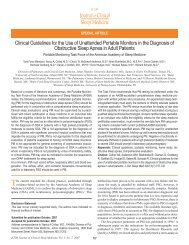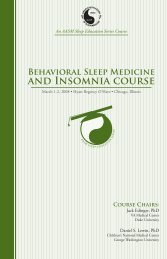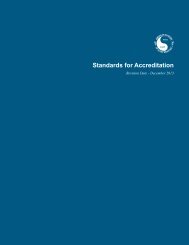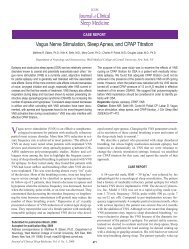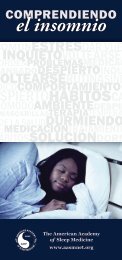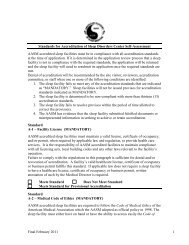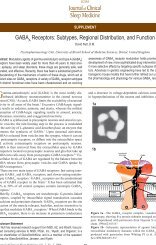Insomnia and Daytime Napping in Older Adults - ResearchGate
Insomnia and Daytime Napping in Older Adults - ResearchGate
Insomnia and Daytime Napping in Older Adults - ResearchGate
Create successful ePaper yourself
Turn your PDF publications into a flip-book with our unique Google optimized e-Paper software.
S Ancoli-Israel <strong>and</strong> JL Mart<strong>in</strong><br />
<strong>in</strong> daytime napp<strong>in</strong>g <strong>in</strong> 10 healthy Japanese women aged 50 to 70<br />
years. 73 Of 5 subjects who took daytime naps under controlled<br />
conditions, 3 subjects elim<strong>in</strong>ated daytime naps with the use of<br />
bright-light therapy <strong>and</strong> 2 reduced their naps. In this study, morn<strong>in</strong>g<br />
bright-light therapy did not significantly improve the number<br />
of nocturnal awaken<strong>in</strong>gs, sleep latency, or sleep efficiency. In another<br />
study, 4 weeks of morn<strong>in</strong>g bright-light therapy for 2 hours<br />
at an <strong>in</strong>tensity of 3000 to 5000 lux significantly <strong>in</strong>creased nighttime<br />
sleep time <strong>and</strong> significantly decreased daytime sleep time<br />
<strong>in</strong> 14 <strong>in</strong>patients with dementia <strong>and</strong> associated sleep <strong>and</strong> behavior<br />
disorders (average age: 75 years). 74 However, other studies have<br />
found no significant change <strong>in</strong> daytime sleep<strong>in</strong>ess follow<strong>in</strong>g improvement<br />
of <strong>in</strong>somnia with bright-light therapy <strong>in</strong> communitydwell<strong>in</strong>g<br />
elderly persons. 68 Further research is needed to establish<br />
tim<strong>in</strong>g, <strong>in</strong>tensity, <strong>and</strong> duration of bright-light therapy for optimum<br />
nighttime <strong>and</strong> daytime effect.<br />
Most studies of hypnotic agents have not evaluated the effects<br />
of treatment on daytime napp<strong>in</strong>g, yet this important endpo<strong>in</strong>t<br />
needs to be <strong>in</strong>vestigated <strong>in</strong> studies of hypnotic agents. In 1<br />
cl<strong>in</strong>ical evaluation of the effect of the hypnotic agent eszopiclone<br />
<strong>in</strong> elderly patients with chronic <strong>in</strong>somnia, daytime naps were<br />
<strong>in</strong>cluded as an efficacy endpo<strong>in</strong>t. 75 In this study, sleep efficacy<br />
(improved sleep latency, sleep ma<strong>in</strong>tenance, <strong>and</strong> total sleep time)<br />
was coupled with significantly reduced duration <strong>and</strong> number of<br />
patient-reported daytime naps, as well as with improvements<br />
<strong>in</strong> patient reports of daytime alertness, sense of well-be<strong>in</strong>g, <strong>and</strong><br />
physical function<strong>in</strong>g. Further <strong>in</strong>vestigations are needed to explore<br />
the cl<strong>in</strong>ical implications of these improvements <strong>in</strong> nocturnal sleep<br />
<strong>and</strong> daytime napp<strong>in</strong>g.<br />
CONCLUSIONS<br />
<strong>Insomnia</strong> <strong>and</strong> daytime napp<strong>in</strong>g are common among elderly.<br />
Although napp<strong>in</strong>g has traditionally been viewed as beneficial, or<br />
at a m<strong>in</strong>imum harmless, this perception has been challenged by<br />
some published data. <strong>Daytime</strong> napp<strong>in</strong>g may perpetuate a cycle<br />
of reduced sleep quality <strong>and</strong> daytime sleep<strong>in</strong>ess <strong>and</strong> has been associated<br />
with <strong>in</strong>creased risk for cardiovascular morbidity or total<br />
mortality, although no causation has been established. These data<br />
suggest that napp<strong>in</strong>g should not be automatically dismissed as <strong>in</strong>consequential.<br />
Further exam<strong>in</strong>ation of this behavior may be warranted.<br />
The mortality f<strong>in</strong>d<strong>in</strong>gs associated with daytime napp<strong>in</strong>g have<br />
been <strong>in</strong>terpreted <strong>in</strong> several ways. First, the association between<br />
mortality <strong>and</strong> daytime napp<strong>in</strong>g suggests that napp<strong>in</strong>g may be a<br />
marker of excessive daytime somnolence, a problem associated<br />
with negative outcomes, 16 rather than as a simple compensatory<br />
strategy for a restricted night sleep. Consequently, some have hypothesized<br />
that excessive daytime somnolence may result from<br />
the presence of an underly<strong>in</strong>g sleep disorder. 76 The conventional<br />
wisdom suggests that a number of older <strong>in</strong>dividuals with excessive<br />
daytime somnolence may have undetected sleep apnea, a condition<br />
with clear age- <strong>and</strong> sex-related differential prevalence that<br />
is l<strong>in</strong>ked strongly to <strong>in</strong>creased cardiovascular risk. 77 While this<br />
may partially expla<strong>in</strong> the relationship between daytime napp<strong>in</strong>g<br />
<strong>and</strong> mortality, some studies have found no association between<br />
snor<strong>in</strong>g (a card<strong>in</strong>al symptom of sleep apnea) or body mass <strong>in</strong>dex<br />
(a risk factor for sleep apnea) <strong>and</strong> napp<strong>in</strong>g-related mortality. 64<br />
One causal hypothesis suggests that the <strong>in</strong>creased heart rate<br />
<strong>and</strong> blood pressure observed directly after the onset of daytime<br />
napp<strong>in</strong>g is similar to the changes seen upon morn<strong>in</strong>g awaken<strong>in</strong>g.<br />
63 These morn<strong>in</strong>g heart-related changes have been l<strong>in</strong>ked to<br />
an <strong>in</strong>creased rate of MI <strong>and</strong> other acute cardiovascular events. 78,79<br />
Increased heart rate <strong>and</strong> blood pressure result <strong>in</strong> <strong>in</strong>creased myocardial<br />
oxygen dem<strong>and</strong>, which subsequently may act as a trigger<br />
for cardiovascular events <strong>in</strong> the morn<strong>in</strong>g after awaken<strong>in</strong>g <strong>and</strong> <strong>in</strong><br />
the afternoon after napp<strong>in</strong>g cessation. Bursztyn et al 14,63 have further<br />
hypothesized that arousal from afternoon napp<strong>in</strong>g may result<br />
<strong>in</strong> an abrupt surge of sympathetic nervous system activity, 80 trigger<strong>in</strong>g<br />
hemodynamic changes (e.g., <strong>in</strong>creased myocardial oxygen<br />
dem<strong>and</strong> <strong>and</strong> bra<strong>in</strong> vascular shear stress precipitated by abrupt elevation<br />
of blood pressure <strong>and</strong> heart rate upon awaken<strong>in</strong>g), as well<br />
as thrombogenic changes that may contribute to cardiovascular<br />
events. 80,81 Further, the rapid <strong>in</strong>crease <strong>in</strong> myocardial oxygen dem<strong>and</strong><br />
immediately after a 2-hour rest (not necessarily result<strong>in</strong>g<br />
<strong>in</strong> sleep) appears similar <strong>in</strong> magnitude to the <strong>in</strong>crease observed<br />
after morn<strong>in</strong>g awaken<strong>in</strong>g <strong>in</strong> healthy young adults. 81 This f<strong>in</strong>d<strong>in</strong>g<br />
suggests that arousal from afternoon napp<strong>in</strong>g, like morn<strong>in</strong>g<br />
arousal, may result <strong>in</strong> a period of <strong>in</strong>creased cardiovascular risk. 63<br />
There is prelim<strong>in</strong>ary evidence, however, that the changes <strong>in</strong> heart<br />
rate upon arousal from napp<strong>in</strong>g are negligible, suggest<strong>in</strong>g lesser<br />
potential for ischemia, compared with the morn<strong>in</strong>g hours soon<br />
after arousal. 82 It is difficult to determ<strong>in</strong>e, however, whether napp<strong>in</strong>g-related<br />
hemodynamic changes directly contribute to mortality<br />
risk or whether the overlap <strong>in</strong> risk factors for these 2 conditions<br />
accounts for the observed relationships. <strong>Daytime</strong> sleep<strong>in</strong>ess<br />
<strong>and</strong> napp<strong>in</strong>g may be directly caused by medical illnesses (<strong>and</strong><br />
medications used to manage cardiovascular risk factors), result<strong>in</strong>g<br />
<strong>in</strong> the observed l<strong>in</strong>k between napp<strong>in</strong>g <strong>and</strong> mortality. Further<br />
research us<strong>in</strong>g objective measures of both sleep apnea <strong>and</strong> daytime<br />
somnolence are needed to fully address this issue.<br />
On the other h<strong>and</strong>, it is plausible that long daytime sleep may<br />
play a direct role <strong>in</strong> enhanc<strong>in</strong>g the risk of mortality. If a causal<br />
relationship between napp<strong>in</strong>g <strong>and</strong> mortality could be determ<strong>in</strong>ed,<br />
then napp<strong>in</strong>g would feasibly represent a lifestyle factor similar<br />
to diet, exercise, <strong>and</strong> smok<strong>in</strong>g status <strong>and</strong>, thus, be amenable to<br />
modification. However, possible mechanisms for this causal relationship<br />
have not yet been thoroughly elucidated.<br />
In contrast to these negative effects, short daytime naps have<br />
demonstrated positive benefits, <strong>in</strong>clud<strong>in</strong>g <strong>in</strong>creased alertness. 12,81<br />
It has also been argued that short afternoon naps practiced <strong>in</strong><br />
adults may be an important stress-cop<strong>in</strong>g mechanism, therefore<br />
hav<strong>in</strong>g a beneficial effect. 81 Given the conflict<strong>in</strong>g evidence, the<br />
cl<strong>in</strong>ical recommendations of these data are not clear.<br />
More research is needed to address many issues related to <strong>in</strong>somnia<br />
<strong>and</strong> napp<strong>in</strong>g <strong>in</strong> the elderly, <strong>in</strong>clud<strong>in</strong>g the cause-<strong>and</strong>-effect<br />
relationship between <strong>in</strong>somnia <strong>and</strong> napp<strong>in</strong>g; the role, if any,<br />
of napp<strong>in</strong>g <strong>in</strong> cardiovascular morbidity <strong>and</strong> total mortality; the<br />
characterization of nappers at risk for cardiovascular morbidity<br />
or mortality; <strong>and</strong> the impact of improv<strong>in</strong>g <strong>in</strong>somnia <strong>and</strong> reduc<strong>in</strong>g<br />
daytime naps on cl<strong>in</strong>ical outcome. The effect of reduced napp<strong>in</strong>g<br />
on nocturnal sleep latency <strong>and</strong> cont<strong>in</strong>uity <strong>and</strong> on next-day cognitive<br />
<strong>and</strong> physical function<strong>in</strong>g also needs to be researched. 80,81<br />
Future <strong>in</strong>somnia treatment-efficacy trials, whether drug or behavioral<br />
therapies, should <strong>in</strong>clude evaluation of next-day benefits <strong>in</strong><br />
terms of reduced daytime sleep<strong>in</strong>ess <strong>and</strong> napp<strong>in</strong>g (daytime wakefulness)<br />
<strong>and</strong> improvement of cognitive <strong>and</strong> physical function<strong>in</strong>g<br />
<strong>and</strong> quality of life.<br />
Journal of Cl<strong>in</strong>ical Sleep Medic<strong>in</strong>e, Vol. 2, No. 3, 2006 340



